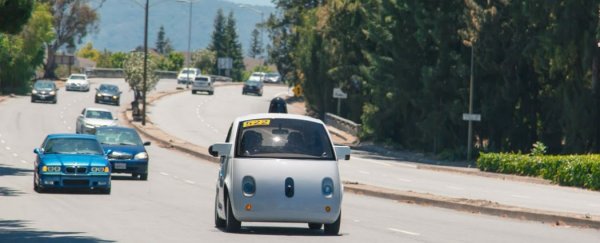Like hoverboards and jetpacks, self-driving cars are one of those 'too-good-to-be-true' technologies that could change everything for everyone living in a big city. Except unlike hoverboards and jetpacks - you've got a lot to prove, Lexus! - self-driving cars are an actual reality right now, and are starting to make real changes to how the residents of Mountain View in California get around.
As Mike Murphy points out at Quartz, these things look like adorable little pandas, and they're getting Californians where they need to go, no driver's license required.
Unfortunately though, Google's self-driving cars still have their training wheels firmly attached - Quartz reports that they're only travelling at 40 km/hour right now, and have a driver behind the wheel at all times in case of an emergency. As we reported back in May, a review found that one in 12 self-driving cars have been in accidents since September 2014, but humans were at fault for the collision, not the cars.
By getting them out on the public roads now, Google is aiming to increase the 1.6 million km of experience that their self-driving cars so far have under their very round belts. More driving means more data on what could possibly go wrong for these cars when they're interacting with regular cars. While the crashes over the past 16 months weren't serious and caused no injuries (and no wonder - they were travelling at less than 16 km/hour at the time) researchers at Google are keen to figure out exactly what kinds of situations will put them in danger, and use that information to further improve their cars' AI.
And together with their own data, they'd like to gather information from people who have actually encountered one of their self-driving cars on the streets too. Chris Ziegler reports for The Verge that Google has launched a website where drivers can recount their experiences of having to interact with one of these sweet-looking bubble-mobiles, telling them if it went smoothly, if it required extra concentration to move around the car, or if it was just kinda weird sharing the streets with something not controlled by a human brain.
"It'll probably help that some of the cars are going to become rolling works of art - how can you hate a cute car covered in an even cuter pattern?" says Ziegler. "Then again, the cars are capped at 'a neighbourhood-friendly 25 mph (40 km/h),' so if you've ever wanted to lay on your horn at an artificially intelligent vehicle that's going way too slow on a public street, this might be a wonderful opportunity."
Just everyone please be patient with these plucky little robots. They're trying their best to create a world where less and less of us are compelled to spend our valuable hours behind the wheel, let's hope they get us there.
